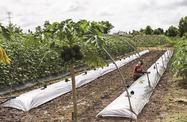Onshore developments, including aquaculture and processing facilities, could help Brunei Darussalam unlock the potential of its burgeoning fisheries industry.
The Sultanate is keen to overcome supply gaps and boost the sector’s contribution to GDP, particularly in the value-added segment, as part of a national drive to diversify the economy away from oil and gas.
Maritime legacy
A one-time maritime hub, Brunei Darussalam’s natural resources – which include 161 km of coastline and an extensive, 36,600-sq-km exclusive economic zone – should support the country’s efforts to expand fisheries revenues.
The sector’s current share of economic output remains low, at just short of 1% of GDP when combined with both forestry and agriculture as of the second quarter of 2015, according to the Department of Statistics. However, the fisheries segment in particular has recorded substantial growth over the last year, expanding by 29.8% year-on-year in the second quarter of 2015.
While the government sees fisheries and aquaculture as potential providers of jobs and private sector investment, it also recognises the need to address the current supply gap.
Local demand remains especially high in the Sultanate, which has one of the highest rates of per capita seafood consumption in South-east Asia, at 47 kg per annum in 2013.
Supply & sustainability
Brunei Darussalam has imposed limits in recent years to preserve local fish stocks and protect delicate coral reefs, which are major breeding grounds for fish. Promoting more sustainable fishing practices also ranks high on the Sultanate’s fisheries agenda.
The country recently renewed a moratorium on new fishing licences, originally implemented in 2008, while also extending the coastal Zone 1 fishing area, where some trawling is banned, from three nautical miles offshore to seven.
While such measures are expected to help restore depleted fish stocks, they have driven down local supply in the interim. Fish processing businesses report having to import catches from outside of Brunei Darussalam in order to maintain their operations – largely from Malaysia (Sarawak and Sabah) – and are still running below capacity.
Richard Chuang, managing director of integrated seafood producer Golden Corporation, highlighted the impact that raw material shortages were having on operations. “It is the most important issue that we are facing at the moment,” he told local media in October, citing production levels of around 20-30% of operational capacity.
While the value of fish and seafood imports has eased slightly in recent years, according to data from the Department of Fisheries, falling from BN$10.3m ($7.3m) in 2009 to BN$5.9m ($4.2m) in 2012, the country continues to rely on imports for roughly half of local consumption.
Supply shortages have also driven up the price of fish. As of the first quarter of 2015, red snapper was trading at around BN$5.70-7.60 ($4-5.40) per kg in Malaysia, compared to BN$18 ($12.75) per kg in Brunei, according to local media reports.
Farming for the future
Efforts to boost supply have largely centred on onshore production, with a focus on developing fish and seafood farms.
The outlook for the aquaculture segment looks promising, with its contribution to the national economy expected to reach BN$200m ($141.4m) by 2023, according to the Department of Fisheries, equivalent to around half of the overall industry.
Boosting aquaculture output would also allow the country to expand its seafood processing and export businesses, which currently account for a relatively small share of the sector’s total value.
Golden Corporation, which breeds and processes organic blue prawns, has acquired 200 ha of new land for aquaculture in a bid to triple production to 3000 tonnes per annum by 2017. The company currently exports roughly 60 tonnes of shrimp per month to China, Taiwan, South Korea and Japan.
Brunei Darussalam has also taken steps to make better use of bycatch. A long-running lack of local demand for certain types of fish has led to high discard rates. Before the country developed a domestic value-added processing industry, reports suggested that as much as 90% of each catch was discarded.
In recent years, efforts in have focused on identifying applications for less marketable fish. Processing plants that turn low-quality catches into commercially viable products, such as surimi and fish oil and pastes, have proven to be successful growth avenues for the industry.
Oxford Business Group is now on Instagram. Follow us here for news and stunning imagery from the more than 30 markets we cover.

